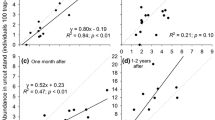Abstract
Human-influenced changes in the diversity and abundance of native wildlife in a southern boreal forest area, which became a national park in 1975, are used to develop working hypotheses for predicting and subsequently measuring the effects of disturbance or restoration programs on groups of interacting species. Changes from presettlement conditions began with early 1900 hunting, which eliminated woodland caribou (Rangifer tarandus) and elk (Cervus elaphus), and reduced moose (Alces alces) to the low numbers which still persist. Increases in white-tailed deer (Odocoileus virginianus), as these other cervid species became less abundant or absent, provided enough alternative food to sustain the system's carnivores until plant succession on previously burned or logged areas also caused deer to decline. With increased competition for reduced food, carnivore species also became less abundant or absent and overexploited some prey populations. The abilities of interacting species to maintain dynamically stable populations or persist varied with their different capacities to compensate for increased exploitation or competition. These relationships suggested a possible solution to the problem of predicting the stability of populations in disturbed systems. For the 1976–1985 period, a hypothesis that the increased protection of wildlife from exploitation in a national park would restore a more diverse, abundant, and productive fauna had to be rejected.
Similar content being viewed by others
Literature cited
Billings, W. D. 1964. Plants and the ecosystem. Wadsworth, Belmont, California.
Burt, W. H., and R. P. Grossenheider. 1976. A field guide to the mammals. Houghton Mifflin, Boston.
Coffman, M. S., L. Rakestraw, and J. E. Ferris 1980. The fire and logging history of Voyageurs National Park. Final Report. Michigan Technological University, Houghton, Michigan.
Cole, G. F. 1976. Management involving grizzly and black bears in Yellowstone National Park, 1970–75. National Park Service Natural Resources, US Department of Interior, Report no. 9.
Cole, G. F. 1981. Alternative hypotheses on ecological effects of meningeal parasite (Parelaphostrongylus tenuis).Journal of the Minnesota Academy of Science 47:8–10.
Cole, G. F. 1982. Restoring natural conditions in a boreal forest park. Pages 411–420in Transactions of the 47th North American wildlife and natural resources conference. Wildlife Management Institute, Washington, DC.
Erickson, A. B., V. E. Gunvalson, M. H. Strenlund, D. W. Burcalow, and L. H. Blankenship. 1961. The white-tailed deer of Minnesota. Technical Bulletin no. 5. Minnesota Division of Game and Fish.
Floyd, T. T., L. D. Mech, M. E. Nelson. 1979. An improved method of censusing deer in deciduous-coniferous forests.Journal of Wildlife Management 43:258–261.
Goodman, D. 1975. The theory of diversity-stability relationships in ecology.Quarterly Review of Biology 50:237–266.
Hall, E. R. 1981. The mammals of North America, 2nd edn., vol. 2. John Wiley and Sons, New York.
Heinselman, M. L. 1970. Landscape evolution, peadand types and the environment in the Lake Agassiz Peatlands Natural Area in Minnesota.Ecological Monographs 40:235–261.
Heinselman, M. L. 1973. Fire in the virgin forests of the Boundary Waters Canoe Area, Minnesota.Quaternary Research 3:329–382.
Horn, H. S. 1968. Regulation of animal numbers, a counter-example.Ecology 49:776–778.
Houston, D. B. 1976. Research on ungulates in northern Yellowstone National Park. Pages 11–27in Research in the parks. Transactions of the National Park Centennial Symposium, December 1971. US Department of Interior, National Park Service Symposium Series, no. 1, 1976.
Houston, D. B. 1978. Elk as winter-spring food for carnivores in northern Yellowstone National Park.Journal of Applied Ecology 15:653–661.
Macnab, J. 1983. Wildlife management as scientific experimentation.Wildlife Society Bulletin 11:397–401.
MacLean, D. A., S. J. Woodley, M. G. Weber, and R. W. Wein. 1983. Fire and nutrient cycling. Pages 111–132in R. W. Wein and D. A. MacLean (eds.), The role of fire in northern circumpolar ecosystems. John Wiley and Sons, New York.
Mech, L. D., and P. D. Karns. 1977. Role of wolf in a deer decline in the Superior National Forest. USDA Forest Service Research Paper NC-148.
Peterson, R. L. 1966. The mammals of eastern Canada. Oxford University Press, Toronto.
Peterson, R. L. 1974. A review of the general life history of moose.Le Naturaliste Canadien 101:9–21.
Poore, M. E. D. 1962. The method of successive approximation in descriptive ecology. Pages 36–69in J. B. Cragg (ed.), Advances in ecological research, vol. 1. Academic Press, New York.
Powell, R. A. 1982. The fisher life history, ecology and behavior. University of Minnesota Press, Minneapolis, Minnesota.
Romesburg, H. C. 1981. Wildlife science: gaining reliable information.Journal of Wildlife Management 45:293–313.
Swain, A. M. 1981. Vegetation and fire history at Voyageurs National Park. Final Report to National Park Service. Center for Climatic Research, University of Wisconsin, Madison, Wisconsin.
Whittaker, R. H. 1970. Communities and ecosystems. Macmillan, New York.
Zaret, T. M. 1982. The stability/diversity controversy: a test of hypotheses.Ecology 63:721–731.
Zaret, T. M. 1984. Ecology and epistemology.Bulletin of the Ecological Society 65:4–7.
Author information
Authors and Affiliations
Rights and permissions
About this article
Cite this article
Cole, G.F. Changes in interacting species with disturbance. Environmental Management 11, 257–264 (1987). https://doi.org/10.1007/BF01867204
Issue Date:
DOI: https://doi.org/10.1007/BF01867204




